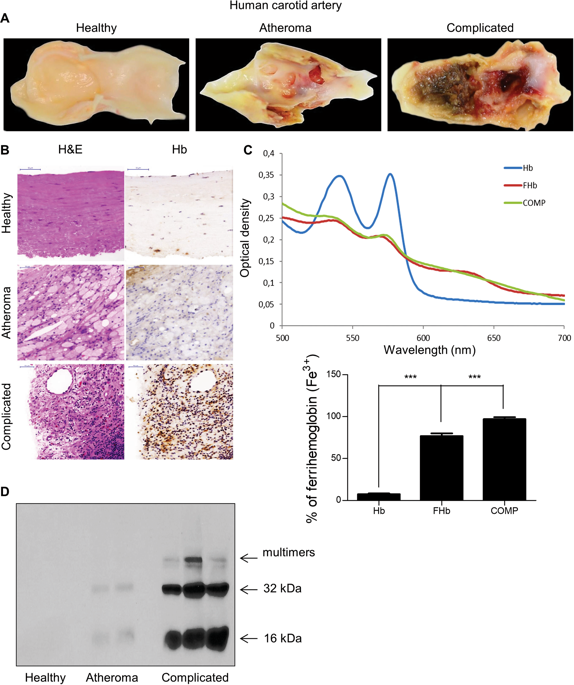当前位置:
X-MOL 学术
›
Lab. Invest.
›
论文详情
Our official English website, www.x-mol.net, welcomes your
feedback! (Note: you will need to create a separate account there.)
Hemoglobin oxidation generates globin-derived peptides in atherosclerotic lesions and intraventricular hemorrhage of the brain, provoking endothelial dysfunction.
Laboratory Investigation ( IF 5.1 ) Pub Date : 2020-02-13 , DOI: 10.1038/s41374-020-0403-x Niké Posta 1, 2, 3 , Éva Csősz 4 , Melinda Oros 1, 5 , Dávid Pethő 1 , László Potor 5, 6 , Gergő Kalló 4 , Zoltán Hendrik 7 , Katalin Éva Sikura 5, 6 , Gábor Méhes 7 , Csaba Tóth 8 , József Posta 9 , György Balla 5, 6 , József Balla 1, 5
Laboratory Investigation ( IF 5.1 ) Pub Date : 2020-02-13 , DOI: 10.1038/s41374-020-0403-x Niké Posta 1, 2, 3 , Éva Csősz 4 , Melinda Oros 1, 5 , Dávid Pethő 1 , László Potor 5, 6 , Gergő Kalló 4 , Zoltán Hendrik 7 , Katalin Éva Sikura 5, 6 , Gábor Méhes 7 , Csaba Tóth 8 , József Posta 9 , György Balla 5, 6 , József Balla 1, 5
Affiliation

|
The lysis of red blood cells was shown to occur in human ruptured atherosclerotic lesions and intraventricular hemorrhage (IVH) of the brain. Liberated cell-free hemoglobin was found to undergo oxidation in both pathologies. We hypothesize that hemoglobin-derived peptides are generated during hemoglobin oxidation both in complicated atherosclerotic lesions and IVH of the brain, triggering endothelial cell dysfunction. Oxidized hemoglobin and its products were followed with spectrophotometry, LC-MS/MS analysis and detection of the cross-linking of globin chains in complicated atherosclerotic lesions of the human carotid artery and the hemorrhaged cerebrospinal liquid of preterm infants. The vascular pathophysiologic role of oxidized hemoglobin and the resultant peptides was assessed by measuring endothelial integrity, the activation of endothelial cells and the induction of proinflammatory genes. Peptide fragments of hemoglobin (VNVDEVGGEALGRLLVVYPWTQR, LLVVYPWTQR, MFLSFPTTK, VGAHAGEYGAELERMFLSFPTTK, and FLASVSTVLTSKYR) were identified in ruptured atherosclerotic lesions and in IVH of the human brain. Fragments resulting from the oxidation of hemoglobin were accompanied by the accumulation of ferryl hemoglobin. Similar to complicated atherosclerotic lesions of the human carotid artery, a high level of oxidized and cross-linked hemoglobin was observed in the cerebrospinal fluid after IVH. Haptoglobin inhibited hemoglobin fragmentation provoked by peroxide. The resultant peptides failed to bind haptoglobin or albumin. Peptides derived from hemoglobin oxidation and ferryl hemoglobin induced intercellular gap formation, decreased junctional resistance in the endothelium, and enhanced monocyte adhesion to endothelial cells. Enhanced expression of TNF and the activation of NLRP3 and CASP1 followed by the increased generation of IL-1β and nuclear translocation of the NF-κβ transcription factor occurred in response to hemoglobin-derived peptides, and ferryl hemoglobin in endothelium was upregulated in both pathologies. We conclude that the oxidation of hemoglobin in complicated atherosclerotic lesions and intraventricular hemorrhage of the brain generates peptide fragments and ferryl hemoglobin with the potential to trigger endothelial cell dysfunction.
中文翻译:

血红蛋白氧化在大脑的动脉粥样硬化病变和脑室内出血中产生珠蛋白衍生肽,引起内皮功能障碍。
红细胞的裂解被证明发生在人类破裂的动脉粥样硬化病变和脑室内出血 (IVH) 中。发现游离的无细胞血红蛋白在两种病理学中都经历氧化。我们假设血红蛋白衍生肽是在复杂的动脉粥样硬化病变和大脑 IVH 中的血红蛋白氧化过程中产生的,从而引发内皮细胞功能障碍。氧化血红蛋白及其产物采用分光光度法、LC-MS/MS分析和检测人颈动脉复杂动脉粥样硬化病变和早产儿出血脑脊液中珠蛋白链的交联。氧化血红蛋白和合成肽的血管病理生理学作用是通过测量内皮完整性来评估的,内皮细胞的激活和促炎基因的诱导。血红蛋白的肽片段(VNVDEVGGEALGRLLVVYPWTQR、LLVVYPWTQR、MFLSFPTTK、VGAHAGEYGAELERMFLSFPTTK 和 FLASVSTVLTSKYR)在破裂的动脉粥样硬化病变和人脑的 IVH 中被鉴定出来。血红蛋白氧化产生的碎片伴随着亚铁基血红蛋白的积累。与人颈动脉的复杂动脉粥样硬化病变类似,IVH 后在脑脊液中观察到高水平的氧化和交联血红蛋白。结合珠蛋白抑制由过氧化物引起的血红蛋白碎片。所得肽不能结合触珠蛋白或白蛋白。源自血红蛋白氧化和亚铁基血红蛋白诱导的细胞间间隙形成的肽,降低内皮细胞的连接阻力,增强单核细胞与内皮细胞的粘附。TNF 的表达增强和 NLRP3 和 CASP1 的激活随后 IL-1β 的产生增加和 NF-κβ 转录因子的核转位响应于血红蛋白衍生肽而发生,并且内皮中的铁血红蛋白在两种病理学中都被上调。我们得出结论,血红蛋白在复杂的动脉粥样硬化病变和脑室内出血中的氧化会产生肽片段和亚铁基血红蛋白,有可能引发内皮细胞功能障碍。TNF 的表达增强和 NLRP3 和 CASP1 的激活随后 IL-1β 的产生增加和 NF-κβ 转录因子的核转位响应于血红蛋白衍生肽而发生,并且内皮中的铁血红蛋白在两种病理学中都被上调。我们得出结论,血红蛋白在复杂的动脉粥样硬化病变和脑室内出血中的氧化会产生肽片段和亚铁基血红蛋白,有可能引发内皮细胞功能障碍。TNF 的表达增强和 NLRP3 和 CASP1 的激活随后 IL-1β 的产生增加和 NF-κβ 转录因子的核转位响应于血红蛋白衍生肽而发生,并且内皮中的铁血红蛋白在两种病理学中都被上调。我们得出结论,血红蛋白在复杂的动脉粥样硬化病变和脑室内出血中的氧化会产生肽片段和亚铁基血红蛋白,有可能引发内皮细胞功能障碍。
更新日期:2020-02-13
中文翻译:

血红蛋白氧化在大脑的动脉粥样硬化病变和脑室内出血中产生珠蛋白衍生肽,引起内皮功能障碍。
红细胞的裂解被证明发生在人类破裂的动脉粥样硬化病变和脑室内出血 (IVH) 中。发现游离的无细胞血红蛋白在两种病理学中都经历氧化。我们假设血红蛋白衍生肽是在复杂的动脉粥样硬化病变和大脑 IVH 中的血红蛋白氧化过程中产生的,从而引发内皮细胞功能障碍。氧化血红蛋白及其产物采用分光光度法、LC-MS/MS分析和检测人颈动脉复杂动脉粥样硬化病变和早产儿出血脑脊液中珠蛋白链的交联。氧化血红蛋白和合成肽的血管病理生理学作用是通过测量内皮完整性来评估的,内皮细胞的激活和促炎基因的诱导。血红蛋白的肽片段(VNVDEVGGEALGRLLVVYPWTQR、LLVVYPWTQR、MFLSFPTTK、VGAHAGEYGAELERMFLSFPTTK 和 FLASVSTVLTSKYR)在破裂的动脉粥样硬化病变和人脑的 IVH 中被鉴定出来。血红蛋白氧化产生的碎片伴随着亚铁基血红蛋白的积累。与人颈动脉的复杂动脉粥样硬化病变类似,IVH 后在脑脊液中观察到高水平的氧化和交联血红蛋白。结合珠蛋白抑制由过氧化物引起的血红蛋白碎片。所得肽不能结合触珠蛋白或白蛋白。源自血红蛋白氧化和亚铁基血红蛋白诱导的细胞间间隙形成的肽,降低内皮细胞的连接阻力,增强单核细胞与内皮细胞的粘附。TNF 的表达增强和 NLRP3 和 CASP1 的激活随后 IL-1β 的产生增加和 NF-κβ 转录因子的核转位响应于血红蛋白衍生肽而发生,并且内皮中的铁血红蛋白在两种病理学中都被上调。我们得出结论,血红蛋白在复杂的动脉粥样硬化病变和脑室内出血中的氧化会产生肽片段和亚铁基血红蛋白,有可能引发内皮细胞功能障碍。TNF 的表达增强和 NLRP3 和 CASP1 的激活随后 IL-1β 的产生增加和 NF-κβ 转录因子的核转位响应于血红蛋白衍生肽而发生,并且内皮中的铁血红蛋白在两种病理学中都被上调。我们得出结论,血红蛋白在复杂的动脉粥样硬化病变和脑室内出血中的氧化会产生肽片段和亚铁基血红蛋白,有可能引发内皮细胞功能障碍。TNF 的表达增强和 NLRP3 和 CASP1 的激活随后 IL-1β 的产生增加和 NF-κβ 转录因子的核转位响应于血红蛋白衍生肽而发生,并且内皮中的铁血红蛋白在两种病理学中都被上调。我们得出结论,血红蛋白在复杂的动脉粥样硬化病变和脑室内出血中的氧化会产生肽片段和亚铁基血红蛋白,有可能引发内皮细胞功能障碍。











































 京公网安备 11010802027423号
京公网安备 11010802027423号